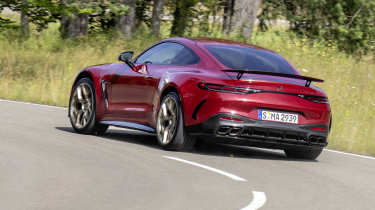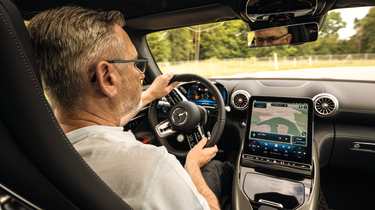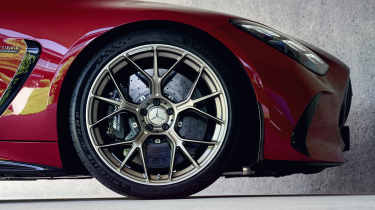Mercedes-AMG GT 63 S E Performance 2025 review – testing the fastest AMG ever
With extraordinary, electrically boosted outputs of 805bhp and 1047lb ft, the latest AMG GT is monstrously fast. But can it also deliver the finesse and engagement that people like us crave?
This is the fastest road car AMG has ever built. How fast? Well, it takes as long to read its name out loud – Mercedes-AMG GT63 S E Performance – as it does to launch and hit 62mph: a mere 2.8sec. That’s faster even than the AMG One supercar. Find yourself a stretch of straight, dry asphalt (it doesn’t have to be very long), engage launch control, hold the brake, pin the throttle, feel the seat belt automatically tension, hear the V8 blat-blat-blat at the optimum revs and release the brake. BLAM! With not even a hint of tyre slip, the AMG GT is gone, into second gear, then third and still hauling in the horizon like you’re in a dolly zoom scene in a movie.
Very impressive, although the question I can’t get out of my head (which has just spent three or four seconds pressed firmly into the headrest) is why did the seat belt tighten? Other, more vital questions crowd in as we back off to a cruise, the main one being, does a GT need to be almost uncomfortably quick? Of course, as with an EV, standing-start performance is largely an unintended consequence. The nature of electric motors is that they produce maximum torque at zero revs, so when you add battery capacity for range you also add performance. However, AMG describes the hybridisation of the GT as an addition in pursuit of performance, adding 200bhp to the V8’s 600bhp. It also gives a pure electric range of 8 miles (13km). The penalty is that all that hybrid hardware adds 225kg to a car that already weighed 1895kg, and just shy of £16k to the list price: it costs £180,745.
More reviews
> Mercedes-AMG GT 63 Pro review – a four-seat 911 GT3 rival?
The electrical hardware is all at the rear; in place of the rear diff is a unit combining the electric motor, a limited-slip differential and a two-speed gearbox, with the 6.1kWh battery pack the size of a small but very heavy suitcase (89kg) above, eating into the luggage space. The familiar M177 twin-turbo V8 and the electric motor are permanently joined by the prop shaft, except for the moment the diff changes gear.
Calculating the total amount of torque is tricky because the V8 is driving through a nine-speed gearbox and the electric motor through two speeds. Think of it as a train with an engine at either end. Their combined output is a massive 805bhp and between 796 and 1047lb ft of torque. Plenty, then.
It’s a handsome car, sleek and aggressive, neatly evolved and enlarged from the previous model to incorporate +2 seating, all the better to take the fight to the Porsche 911 Turbo, which it resembles more than ever, especially around the window line and rear haunches. It sits well on lightweight, web-like 21-inch alloys, which are generously shod with 305/30 rears and just one size smaller 295/30 fronts. They frame massive carbon-ceramic brakes, which help reduce unsprung mass, yet a fixed glass sunroof is standard. You can option a carbonfibre pack that adds a lightweight splitter, sills, rear apron and fixed rear wing. The positioning of the electrical hardware resets the weight distribution, giving a slight rearward bias. Can the hybrid GT add fine, all-round dynamics to incredible performance?
Drop into the comfortable and supportive driver’s seat, press the start button, and the instruments that come up in the digital dash take some moments to decipher and digest. As road cars go, this has to be one of the most complex. There are the numerous switches on the four horizontal spars of the steering wheel and two mode switches hanging from the wheel’s centre, one for the drive mode, the other for quick access to damper settings and AMG presets. Then there’s the massive flat screen that looks like a home computer monitor turned on end and leant up against the centre console. This is packed with all the functions they couldn’t fit elsewhere, of which there are many. If you struggle to know which drawer the detergent goes into in your washing machine, this car will give you the heebie-jeebies.
There are various options for the digital instrument display, one of which brings up a set of traditional instruments – simple round speedo and tacho with needles. All you have to do is find the right menu, then sub-menu and scroll through the options. There are multiple drive modes, too. Left to its own devices, the GT starts in EV mode, a short, rich and meaningful boot-up sound announcing it’s ready to go. It has adequate in-town pace in this mode, accelerating and decelerating with an appealing electrical whine, and once the battery has drained, the V8 kicks in with its classic off-beat rumble. At lower speeds, the slightly ethereal sounds of the hybrid drivetrain interplay with the woofle of the V8, giving an intriguing and appealing soundscape.
The ride seems good. The GT is equipped with AMG’s semi-active roll control, which dispenses with anti-roll bars and should allow the wheels to articulate more freely over bumps in a straight line, improving comfort. Road noise seems well suppressed too, though this first drive is in Germany, which generally has some of the finest road surfaces, so it’s hard to be definitive about either aspect.
Of course, what you’re itching to do is pin the throttle, and when the opportunity arises, it doesn’t disappoint. At anything less than 100mph the kick is savage, the electrical well delivering first, eliminating what little turbo lag the twin-turbocharged V8 has, and then the two pair up to deliver a double whammy. Your unsuspecting passenger’s head will impact the headrest and stay there for as long as you keep the throttle pinned.
It’s almost Tesla/Taycan instantaneous, though the sound is classic, heavy-beat V8, its volume dependent on the drive mode. The right-hand rotary hanging from the steering wheel cycles through the options while the central screen offers further tuning choices for drivetrain, damping and the like in each mode, plus some AMG presets. Via the rotary you can also set the regen level and, apparently, access a scalable slip control (like the similar system that works brilliantly on BMW’s M3/M4) that would be useful in drift mode, which is also tucked away somewhere in the system.
On the road, drifting isn’t something you find yourself contemplating, despite the amount of potential under your right foot. The GT S E is rear-drive until its rear Michelins can’t cope, and then drive is sent to the fronts, though in the dry not once do I get the feeling that the rear tyres are struggling (it might be different in the wet). Another reason why drifting isn’t uppermost in your thoughts is the sense that this is a wide, heavy car, a feeling that never fades, even when it’s bolting for the horizon.
When you add mass you add inertia, which is the enemy of agility. As with the new BMW M5, to mitigate the increased kerb weight, AMG has given the hybrid GT rear-wheel steering as standard. It gives counter-steer for added agility at lower speeds and parallel-steer for stability at higher speeds. Occasionally you can detect the rear steer helping to turn the car, the chassis beneath you feeling surreally responsive for a moment, but there’s only so much performance you can use when the road gets twisty because the GT’s width means you still have little road to play with.
Press on, getting into the throttle early in the corners, and those fat front tyres protest, pushing wide with an indignant squeal of understeer. Such is the scope of the set-up options that if you can navigate the menus you can work around that by selecting the sportiest dynamic settings to make the car as agile as possible and relax slip control, so the throttle is helping to steer the rear a little too.
The car still feels heavy and wide, just surprisingly willing. However, there are two basic issues that sap your enthusiasm and interrupt your efforts to establish a flow and a rhythm. The first is the steering, which is woolly and lacking feel on-centre, and heavy and resistant moving away from centre. The second is the brake pedal feel, which is initially rather dead, so you end up chasing the bite point when you simply wanted to check your speed.
That said, the steering is absolutely spot-on later in our drive, on a derestricted autobahn, where the acceleration is still staggering. The way the GT piles on speed well into three figures is unreal. I imagine it hits its top speed of 199mph (320kph) like most cars hit the rev-limiter in second gear. At monster speeds it feels rock-solid, relaxed almost, and the sight of its aggressive front end in the mirror clears the outside lane effectively too. This feels very much like the hybrid GT’s natural habitat.
The fastest, most potent and also the heaviest AMG GT yet created leaves me conflicted. It’s an impressive performance car but not a great driver’s car. Thing is, both the steering and the brakes feel like tuning issues that you imagine could be resolved relatively easily. They wouldn’t transform the GT into a compelling and tactile driver’s car, but they would certainly help it feel a little less bulky and a bit more wieldy.
Ultimately, the mass of this hybrid AMG GT is inescapable and affects the car’s appeal but, as with the new BMW M5, if we want to keep enjoying big-capacity V8s like this, hybrid looks like the best option.
Mercedes-AMG GT 63 S E Performance specs
| Engine | 4-litre twin-turbocharged V8 & electric motor |
| Power | 805bhp (604bhp V8 & 201bhp electric motor) |
| Torque | 797lb ft – 1047lb ft |
| 0-62mph | 2.8sec |
| Top speed | 199mph |
| Transmission | Nine-speed AMG Speedshift MCT |
| Electric range | 8 miles |
| Price | £180,745 |









